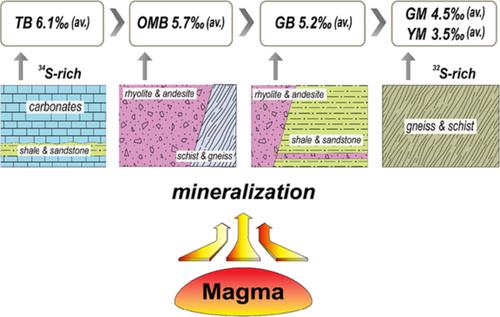韩国金属矿床硫同位素组成的区域差异
IF 0.8
4区 地球科学
Q3 GEOLOGY
引用次数: 2
摘要
朝鲜半岛南部由五大大地构造道组成,分布着各种金属矿床。通过对全省177个金属矿床硫同位素资料(n = 1574)的回顾,分析了不同围岩和地质背景下各省份硫化物矿物硫同位素特征。京畿地块和岭南地块与前寒武纪变质岩和侏罗纪花岗岩体相关的各金属矿床的平均δ34S值分别为- 7.1 ~ +10.3‰(av. +4.5‰)和- 3.6 ~ +7.8‰(av. +3.5‰)。太白山盆地δ34S值最高,为−0.4 ~ +13.2‰(平均±6.1‰)。这主要受海相碳酸盐寄主岩中硫酸盐硫的影响。玉川变质带由变质沉积岩和变质火山岩组成,其同位素变化范围为+1.9 ~ +8.3‰(平均值为+5.7‰)。庆尚盆地硫同位素分布范围为- 1.2 ~ +11.7‰(±5.2‰),可划分为两个带:内带δ34S值较高,与白垩纪火山岩和磁铁矿系花岗岩类有关;外带δ34S值较低,与富有机质沉积岩有关。各大地构造省金属矿床硫同位素变化主要受火成岩硫和固有围岩硫源、富32S沉积硫(如前寒武纪变质沉积岩和富生物成因硫沉积岩)和富34S海水硫(如碳酸盐岩和酸性至中级火山岩)的影响。这些围岩对韩国花岗岩和金属矿床的δ34S值随时间、矿石成因类型和矿石种类的变化也有一定的影响。本文章由计算机程序翻译,如有差异,请以英文原文为准。

Regional variations of sulfur isotope compositions for metallic deposits in South Korea
Southern Korean peninsula comprises five major geotectonic provinces, throughout which various metallic deposits are distributed. We reviewed sulfur isotope data (n = 1,574) of sulfide minerals collected from previous works for 177 metallic deposits in the provinces to interpret the sulfur isotope characteristics of each province, comprising different wall rocks and geologic settings. The averaged δ34S values of each metallic deposit associated with Precambrian metamorphic rocks and Jurassic granitoids in the Gyeonggi massif and Yeongnam massif range from −7.1 to +10.3‰ (av. +4.5‰) and from −3.6 to +7.8‰ (av. +3.5‰), respectively. The Taebaeksan basin produced the highest δ34S value among the five, −0.4 to +13.2‰ (av. +6.1‰). This was influenced by sulfate sulfur derived from marine carbonate host rock. The Okcheon metamorphic belt, comprising metasedimentary and metavolcanics rocks, shows an isotope range from +1.9 to +8.3‰ (av. +5.7‰). The sulfur isotope distribution of the Gyeongsang basin with a range from −1.2 to +11.7‰ (av. +5.2‰) can be divided into two zones: higher δ34S values from the inner zone related to the volcanic rocks and magnetite‐series Cretaceous granitoids, and lower δ34S values from the outer zone related to the organic‐rich sedimentary rocks. Sulfur isotope variations of metallic deposits in each geotectonic province were mainly influenced by igneous sulfur and inherent wall rock sulfur sources, 32S‐enriched sedimentary sulfur (e.g., Precambrian metasedimentary rocks and biogenic sulfur‐rich sedimentary rocks), and 34S‐enriched seawater sulfur (e.g., carbonates and acid to intermediate volcanic rocks). These wall rocks also contributed to the changes in δ34S values for granitoid rocks and metallic deposits by time, ore genetic type, and ore species in South Korea.
求助全文
通过发布文献求助,成功后即可免费获取论文全文。
去求助
来源期刊

Resource Geology
地学-地质学
CiteScore
2.30
自引率
14.30%
发文量
18
审稿时长
12 months
期刊介绍:
Resource Geology is an international journal focusing on economic geology, geochemistry and environmental geology. Its purpose is to contribute to the promotion of earth sciences related to metallic and non-metallic mineral deposits mainly in Asia, Oceania and the Circum-Pacific region, although other parts of the world are also considered.
Launched in 1998 by the Society for Resource Geology, the journal is published quarterly in English, making it more accessible to the international geological community. The journal publishes high quality papers of interest to those engaged in research and exploration of mineral deposits.
 求助内容:
求助内容: 应助结果提醒方式:
应助结果提醒方式:


